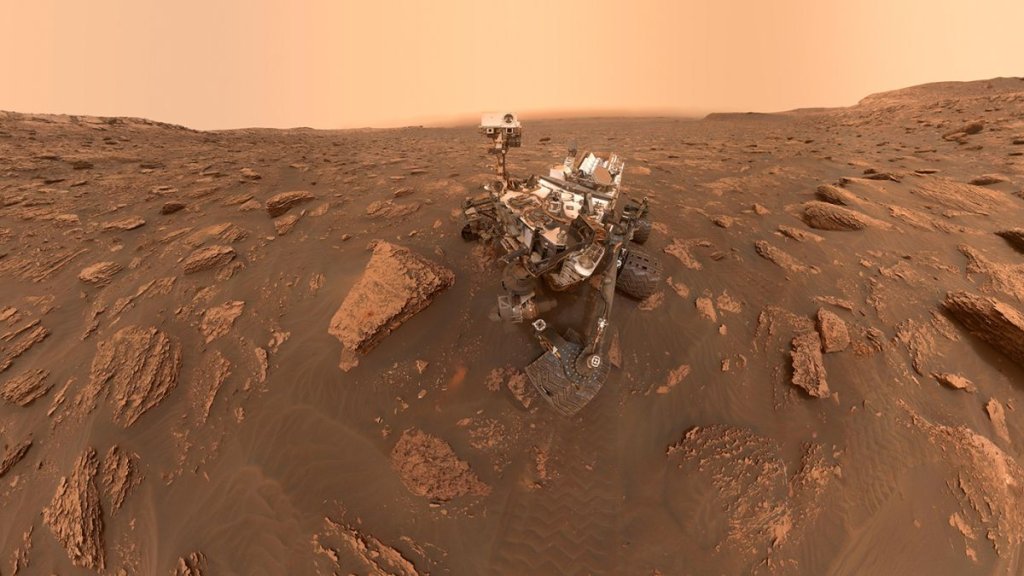NASA’s Curiosity Mars rover will soon race over the surface of the Red Planet more quickly thanks to a new upgrade.
The software update aboard the Curiosity rover, completed on April 7, brings around 180 improvements to the robot, the most significant of which are boosted driving capabilities that will also reduce the wear and tear on Curiosity’s wheels.
Curiosity, which has been exploring Gale Crater on Mars since August 2012, went into hibernation between April 3 and April 7 to receive the upgrade. The software boost will assist Curiosity in its mission to search for traces of extinct microbial life in this ancient dry Martian lake bed, NASA officials wrote.
“The flight software is essential to our mission, so this is a big deal for our team,” Curiosity project manager Kathya Zamora-Garcia, based at NASA’s Jet Propulsion Laboratory in southern California, said in a statement. (opens in new tab) “This is a major software update, and we had to make sure we did it right.”
Related: NASA’s Mars rover Curiosity sees dazzling ‘sun rays’ over Red Planet
The biggest changes in the update are to Curiosity’s mobility, however, and these improvements could help the robot keep rolling over the Martian surface for many more years, NASA osaid. uality of messages relayed back to Earth.
Other changes simplify code that has been part of Curiosity since 2012, which NASA says will improve the robot’s abilities for many more years of Mars trekking. (The rover as received multiple software patches during its 11 years of Mars exploration so far.)
(opens in new tab)
Curiosity now ‘thinks on its feet’ like Perseverance
Curiosity’s fellow Mars rover, the car-sized Perseverance, landed on Mars in 2021 and can “think on the move.” This capability allows Perseverance to navigate around rocks, sand traps, and other obstacles in its stomping ground, which is another dry Martian lake bed dubbed Jezero Crater.
Perseverance navigates by constantly snapping pictures of the terrain ahead, and then processing them with a dedicated computer that allows autonomous navigation during one continuous drive.
Curiosity can’t do this because as an older rover, it lacks a dedicated onboard computer. Instead, Curiosity navigates by breaking its route down into segments and halting to process imagery of the terrain following the completion of each segment. This process requires starting and stopping many times over the course of a long drive.
Related: Mars Rover Curiosity to receive ‘brain transplant’
(opens in new tab)
While the new software update can’t allow Curiosity to embark on a smooth, non-stop drive like Perseverance, it will help the older rover process terrain images more quickly.
“This won’t let Curiosity drive as quickly as Perseverance, but instead of stopping for a full minute after a drive segment, we’re stopping for just a moment or two,” Curiosity’s engineering operations team chief, Jonathan Denison, said in the same statement.
“Spending less time idling between drive segments also means we use less energy each day. And even though we’re almost 11 years old, we’re still implementing new ideas to use more of our available energy for science activities.”
(opens in new tab)
Keeping Curiosity’s wheels turning
In 2013, after just a year of traveling, the Gale Crater operators noticed that Curiosity’s treads were breaking. They realized this was the result of the robot rolling over sharp rocks that were chipping away its treads.
The NASA team attempted to mitigate this damage by introducing an algorithm to Curiosity. The software adjusts the rover’s speed when traveling over certain rocks, thus improving traction and reducing wheel wear.
Related: Rugged Mars has taken big bites out of the Curiosity rover’s wheels (photos)
The 2023 update takes this protection a step further by giving Curiosity two new mobility commands, reducing the amount of steering the rover must perform while driving in an arc toward a specific waypoint. Less steering means Curiosity both reaches its target more quickly, and decreases the amount of wear that inherently comes from steering.
The inspiration for this improvement actually comes from two Mars rovers that predate Curiosity. “That ability was actually dreamed up during the Spirit and Opportunity days,” Denison said, referring to twin NASA rovers that landed on the surface in 2004 and outlasted their 90-sol or Martian day lifetime by more than a decade. “It was a ‘nice to have’ (feature) they decided not to implement.”
The new software won’t just benefit Curiosity itself, but will also streamline the work of its operating team and human drivers who must create plans for the robot that contain hundreds of commands.
The rover team will be able to more smoothly control the sample-collecting robot arm of Curiosity, as well as more accurately point the “head” of the rover atop its protruding mast.
The update will also make future software improvements easier to implement. Overall, Denison said, the Curiosity team is relieved that this major software update for the rover is working according to design.
“The idea of hitting the install button was a little scary,” Denison concluded. “Despite all our testing, we never know exactly what will happen until the software is up there.”
Follow us on Twitter @Spacedotcom (opens in new tab) or Facebook (opens in new tab).

